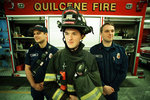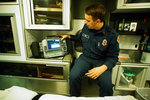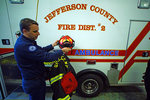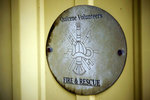As calls for service continue to rise, along with training requirements and equipment costs, fire departments in Jefferson County – like those nationwide – are struggling to attract and retain …
This item is available in full to subscribers.
We have recently launched a new and improved website. To continue reading, you will need to either log into your subscriber account, or purchase a new subscription.
If you had an active account on our previous website, then you have an account here. Simply reset your password to regain access to your account.
If you did not have an account on our previous website, but are a current print subscriber, click here to set up your website account.
Otherwise, click here to view your options for subscribing.
* Having trouble? Call our circulation department at 360-385-2900, or email our support.
Please log in to continue |
|




As calls for service continue to rise, along with training requirements and equipment costs, fire departments in Jefferson County – like those nationwide – are struggling to attract and retain volunteers.
“The whole area is faced with the same challenge, all five fire districts,” said Gordon Pomeroy, fire chief at East Jefferson Fire Rescue (EJFR). “I don't see it going away any time soon.”
Fire departments nationwide have always relied on volunteers. That's still true today, especially for rural departments. In 2014, some 95 percent of volunteer firefighters nationwide worked in departments serving fewer than 25,000 people, according to the National Fire Protection Association (NFPA).
Still, volunteer ranks nationwide have given way to more paid firefighters over the last 30 years, with the number of firefighters who make it their career up more than 50 percent and the number of volunteers down 11 percent, according to the NFPA.
When Larry Karp was hired as Quilcene Fire Rescue chief in 2013, the department was comprised entirely of volunteers – 28, to be exact. That number was down from 60 in 1985 and 49 in 1991.
“I worked really hard to recruit people,” Karp said, noting that he increased his roster to 34 by the end of 2014, not including five resident volunteers who earn a monthly stipend of $900 or $3.82 an hour.
“Many of those people from the 1980s were either U.S. Forest Service employees or loggers in the area,” he said. “Many of those people are still in the area, but they're in their 60s, 70s and 80s now. And I do have volunteers who are in their 70s who are very enthusiastic, but there's a limit to what they can do for us. We're not sending them into a house fire or expecting them to carry a patient down a flight of stairs.”
Today, Quilcene boasts 19 volunteers, 12 of whom are over age 50 and three of those are over age 70. Those volunteers respond to calls from wherever they happen to be and earn about $10 for each.
After passing an initial test, they embark on hundreds of hours of fire and medical training to enter a burning building or provide aid, for example, but in Quilcene, they can get by with 20 hours of fundamental training and a practice burn. Resident volunteers and many citizen volunteers find themselves consumed with hundreds of hours of training and studying.
“Quite frankly, a volunteer department is treated the same way as a full-time department when it comes to training hour requirements and following NFPA standards,” he said.
Karp currently has three people in his Resident-Firefighter-in-Training program, though one is expected to leave at the end of April for paramedic training. In Quilcene, that program began in 2010 with room for six people, typically younger firefighters feeling out a career, who work 48-hour shifts, sleeping at the station.
In 2014, some 85 percent of fire departments nationwide were all or mostly volunteer, protecting more than 35 percent of the U.S. population, according to the NFPA. While there are fewer of those departments than in 1986, career or mostly career departments have jumped 46 percent.
GRANT, LEVY
For the first time in the department's history, Karp hired three full-time employees in January with a $396,000 grant from the Federal Emergency Management Agency and Department of Homeland Security.
Those hires are Lt. Mark McCrehin, EMT, and Lt. Kevin Winn, EMT, both of Quilcene, and firefighter/paramedic Jess Godsalve of Poulsbo. All were part of the resident volunteer program.
The two-year Staffing for Adequate Fire and Emergency Response (SAFER) grant, awarded in July 2015, affords Karp time to find a way to pay for those hires beyond the grant's two-year period.
Toward that end, Karp is hoping his district's voters approve the department's first ever emergency medical services (EMS) levy on the April 26 ballot. That six-year property tax levy would begin in 2017 and bring in $165,000 annually at a rate of 50 cents per $1,000 of assessed property value. Ballots are to be mailed locally April 6.
“The reason I need paid staffing is because of the lack of volunteers,” he said. “If I had more volunteers, I might not need the career people, but I don't see that trend changing any time soon, especially given the demographics in Jefferson County.”
Jefferson County boasts the oldest average population in the state, according to the U.S. Census Bureau. Quilcene is the only fire department in Jefferson, Mason, Clallam and Kitsap counties that has not enacted an EMS levy.
In November 2014, voters approved a 50-cent increase in the department's fire levy, the first since that levy was created in 1988, bringing the rate to $1.25 per $1,000 of assessed value.
“We haven't asked for a lot of money here in Quilcene,” Karp said. “If we weren't trying to better our staffing with the full-time guys, we could still make ends meet without the EMS levy, but we're trying to improve our service.”
Karp said a key benefit of having career firefighters on staff is that he can require them to get further training, such as through an advanced emergency medical technician (EMT) course, or courses in pump operations and wild land firefighting.
“I can't make the volunteers do it, but we can improve the skills of our paid guys,” he said.
VOLUNTEERS 'DWINDLING'
EJFR Chief Pomeroy said the number of volunteers in his department has fallen by 70 percent since 2010, from 27 to 8.
“The fact of the matter is the pool of individuals interested in spending that amount of time is dwindling,” he said.
For many, the pay is not enough to live on. That's why, prior to his being hired, Lt. McCrehin flipped the script, working 96 hours on and 48 off for a year and a half as a resident volunteer. Still, Jefferson County fire chiefs said neither they nor their volunteers do it for the money.
“Some people get into this and realize it's not for them,” Karp said. “They don't like emergency scenes; they don't like blood; they don't like getting up at 2 a.m.; they don't like leaving their families. But for those who end up sticking with it, they say it's not because of the money, it's because they want to help their community.”
Brad Martin, Port Ludlow Fire & Rescue chief, currently has three citizen volunteers and two of a potential six resident volunteers.
“We've been trying to get creative just getting volunteers in here, so we have opened it up to farther away areas,” said Martin, who has brought in volunteers from Gig Harbor and Federal Way. “I think we've been as proactive as we can in our area and we still don't get any applications.”
In Quilcene, Karp struggled to keep the station staffed during the summer of 2014.
“We were rolling the dice that summer because many of our resident volunteers didn't want to come in,” he said. “They wanted to be out doing other things. We got lucky, but we won't always be so lucky.”
That prompted him to apply for the two-year federal SAFER grant. It also inspired him to pursue high school students.
“My initial thought was to recruit at the high school for junior firefighters in training,” said Karp, who spoke to Quilcene students in September 2015 about the department's cadet program. “There wasn't a single question and most had their heads buried in their cell phones as we talked.”
Despite the failed effort, the department has had one cadet, now a high school senior, for three years, and Karp expects he'll soon become a resident volunteer.
“Last school year he started taking his open period to come to the fire house,” he said of the cadet. “This year he gets credit for coming here one period a day.”
Martin said he plans to reach out to Chimacum High School students during career days and school events.
“Resident volunteers in rural areas like this get to be on the front lines,” Martin said. “The experience a resident volunteer might get over here supersedes what they might get at a bigger department. If you give us two years here, we'll get you trained up and ready to join a fire department.”
Pomeroy said it costs thousands of dollars to train a resident volunteer, and most end up getting hired elsewhere.
“We've had some who were hired by other departments because they are so well trained and they're constantly applying for work,” he said.
CALLS, COSTS
Calls for service nationwide have jumped 167 percent in the last 26 years, according to the NFPA. Across the board, roughly 75 percent of calls are medical-related.
“We're seeing an increase in medical calls,” said Karp, who's seen his Quilcene district's total calls jump 77 percent since 2011. “A very small percentage of calls are actual fires. I'm looking for volunteers who are already EMTs or someone who is willing to work hard to go to school and get certified.”
EJFR calls for service have jumped 33 percent since 2011, and the most frequent customers are in Port Townsend at Discovery View Retirement Apartments, Life Care Center and Seaport Landing, public information officer Bill Beezley said.
“With the call volumes we're seeing, I don't know how we're doing it,” Pomeroy said, noting that EJFR is averaging 13 calls a day, each of which can take several hours to complete. “We're running with a bare bones crew of anywhere from seven to nine people a day.”
At the same time, equipment costs have risen 170 percent since 1980, according to the NFPA. The cost of a self-contained breathing apparatus is more than $5,000, five times what it was in the 1980s.
For example, in the summer of 2014, Karp used a Federal Emergency Management Agency grant to purchase a heart monitor/defibrillator for $35,000 and seven automated external defibrillators for $2,500 each.
Grant money has become a lifeline for rural departments like Quilcene's as other funding sources are harder to come by, such as federal timber tax revenues, which have fallen from $160,691 in 2005 to less than $1,000 in 2014, Karp said.
“The decrease in the timber revenues has hampered us during the past few years and was one of the reasons we requested a levy increase in 2014,” he said.
Karp said as call volumes increase, so too does the need to provide mutual aid services to neighboring fire districts. For a thinly staffed department like Quilcene's, that means volunteers are needed to staff the station when on-duty staff responds to a neighboring district.
“That's a situation where I need my volunteers to make themselves available,” he said. “If my volunteers hear our ambulance go out, they need to come out and staff the station. They can also radio in their availability. It may look like we have proper staffing and volunteers, but many times we are very lucky to be able to handle a call, especially at times when a second call comes in.”
Despite a dearth of volunteers, Karp said his department has never failed to respond to a call.
“We're covering all our calls, but we want to be proactive,” he said, noting that if citizens in danger can't count on volunteers to respond, they can surely count on paid staff firefighters.
“Unlike in the big city, we can't afford to have fully funded, full-time emergency services. What we can afford is one full-time guy staffing that station every day. But even that's not really enough.”